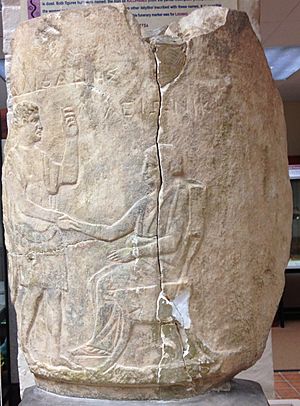Museum of Classical Archaeology, Adelaide facts for kids
The Museum of Classical Archaeology is a special place at the University of Adelaide in South Australia. It's like a classroom filled with ancient treasures! This museum helps students learn about the amazing worlds of Archaeology, Greek, and Roman history.
Discovering Ancient Worlds: The Museum's Story
How the Collection Began
The idea for this museum started a long time ago, around 1910. A professor named H. Darnley Naylor thought the university needed a museum for ancient history. He imagined it would hold old coins that had been given to the university.
More coin collections were added in the 1920s and 1930s. But it wasn't until the 1960s that the Classics Department got its first display case. They also received a small group of ancient items, mostly Greek pottery.
As more students wanted to learn about Greek and Roman archaeology, the collection grew. In 1979, students and teachers even built a big model of Athens for an exhibition.
Opening the Museum Doors
By 1980, the collection was too big for its old spot. The university decided to move it to a grand room in the historic Mitchell Building. The museum officially opened to the public in 1983. Dr. Frank Sear was its first director.
Many of the museum's items are owned by the university. But it also has ancient Greek and Roman objects on loan. These come from the South Australian Museum and the Art Gallery of South Australia. This teamwork still happens today!
The Greek community in Adelaide has also helped a lot. They donated about forty copies of Classical and Hellenistic sculptures. These were gifts from the Greek Government.
Growing with New Treasures
To celebrate the museum's opening in 1983, a special bronze helmet was bought. It was a Corinthian helmet, popular around 600 BC. Professor A. D. Trendall also gave the museum a Campanian vase called a lekythos.
A group called "Friends of the Museum" was also started. They help organize public talks about archaeology. They also raise money to buy more ancient objects.
The next year, a chance came to add a whole new collection. Arthur Dannatt's personal collection was for sale. With help from the Friends, the museum bought all his items. This made the museum even more diverse. It now had objects from Egypt and Mesopotamia, not just Greece, Etruria, and Rome.
The Museum Today
In the early 1990s, Dr. Margaret O'Hea became the new director. She helped add items from Near Eastern cultures. Some of these came from Sydney University's digs at Pella. The museum continues to grow thanks to private donations.
For a while, the museum couldn't stay open all the time. But now, school groups can visit by appointment. Also, dedicated volunteers from the university help open the museum once a month. You can find out more about public talks on their Facebook page and Eventbrite.
Amazing Artifacts: What You Can See
Ancient Egypt's Secrets
The museum has many items from ancient Egypt. You can see small charms called amulets, figurines, and burial items. These come from different periods, from the New Kingdom to later times.
There's a special table for offerings and a stone slab called a stele. These are from the New Kingdom and were acquired long ago. You can also see pottery from graves found by John Garstang at Beni Hassan in Egypt. These are on loan from other museums.
Treasures from the Near East
This part of the collection shows tools from the Stone Age. These Paleolithic and Neolithic stone tools were found in Jordan. There's also pottery from Bronze Age and Iron Age tombs. These were excavated by a Sydney University team in Pella, Jordan.
You can also find pottery, clay tablets with ancient writing (cuneiform), and figurines from the city of Ur. Ur was an important city in southern Mesopotamia.
Greek and Cypriot Wonders
The museum has a good collection of pottery from Cyprus. These pieces show how pottery changed from the Early Bronze Age to the Iron Age.
From Greece, you can see pottery and lamps from different periods. The famous Corinthian bronze helmet is here. There's also a piece of a marble vase from Attica. It shows a woman named Leonike and her husband Kalliphanes.
Early Italian Cultures
Before Rome became powerful, other cultures thrived in Italy. The museum displays items from the Villanovan and Etruscan people. You can see their pottery and bronze objects.
One highlight is a painted clay coffin from Etruria. It shows a young man relaxing, as if at a feast. This coffin was made when Rome started to control Etruria.
Roman and Byzantine Finds
The Roman collection includes small bronze figurines from Gaul and Egypt. There are also marble sculptures used in funerals. From Roman and early Byzantine Egypt, you can see clay figurines. There's also a piece of Coptic fabric and a souvenir flask of Saint Menas.
A few early Islamic and medieval objects are also on display. They help show how culture changed after the Roman Empire.
Glass Through Time
The museum has a wide variety of glassware. You can see flat beads from Mycenaean times. There's a small perfume bottle called an aryballos from the Classical period. Later, you can find Roman and Byzantine glass vessels, both blown and molded.



